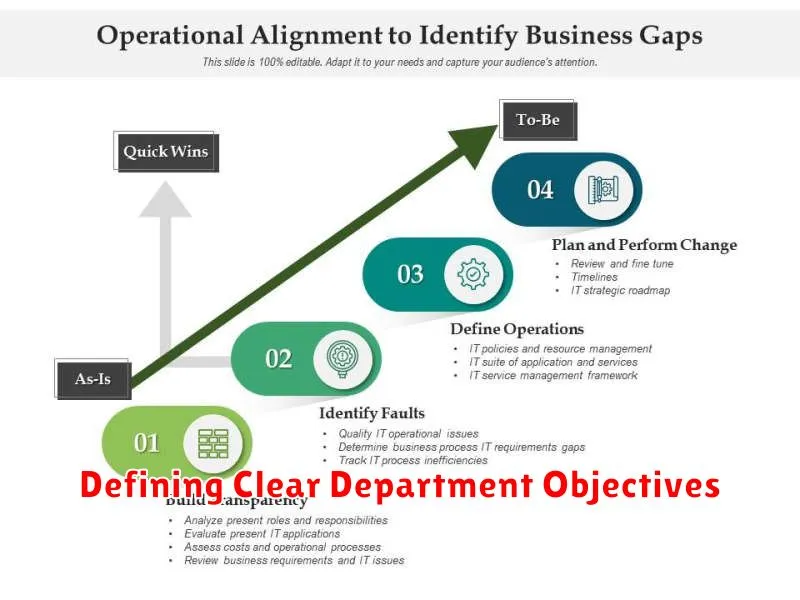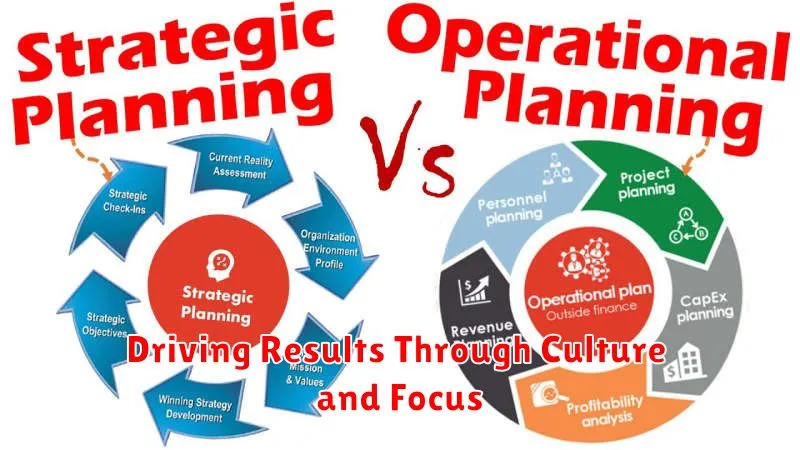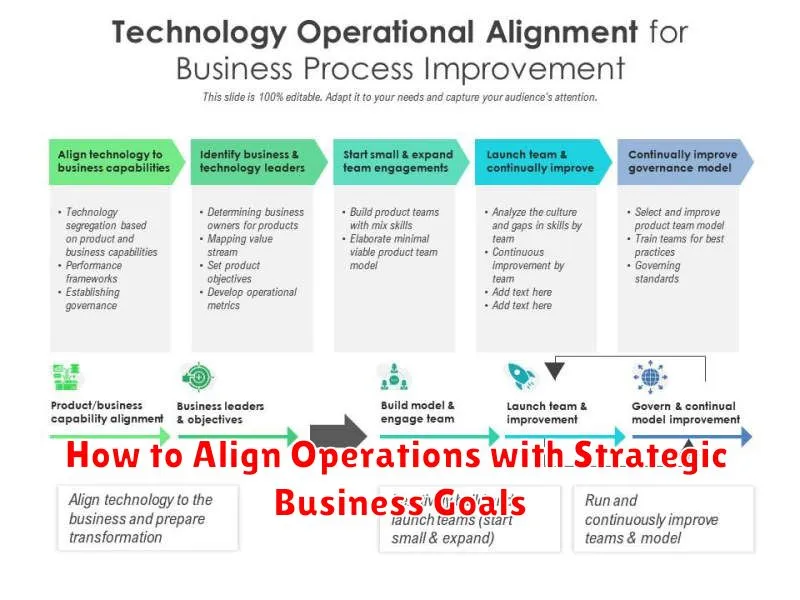In today’s dynamic business environment, achieving sustainable success requires more than just efficient operations. It demands a meticulous alignment of operations with overarching strategic business goals. This crucial synchronization ensures that every operational activity, from production and logistics to customer service and innovation, directly contributes to the realization of the organization’s strategic vision. Failing to establish this alignment can lead to wasted resources, missed opportunities, and ultimately, an inability to achieve desired outcomes. This article will provide a comprehensive guide on how to effectively align operations with strategic business goals, enabling your organization to thrive in competitive markets and achieve sustainable growth.
Aligning operations with strategic business goals is not a one-time event, but rather an ongoing process that requires constant monitoring, evaluation, and adjustment. This article will delve into the key steps involved in achieving and maintaining this crucial alignment. We will explore how to clearly define your strategic business goals, translate them into actionable operational objectives, establish effective performance metrics, and foster a culture of collaboration and communication. By implementing the strategies and best practices outlined in this article, you can transform your operations into a powerful engine for driving strategic success and achieving long-term business goals.
Why Operational Alignment Matters
Operational alignment is crucial for achieving strategic business goals. When operations are aligned, every activity, process, and resource contributes directly to the overall objectives. This creates a synergistic effect, maximizing efficiency and minimizing wasted effort.
Without alignment, organizations risk working at cross-purposes. Individual departments may pursue their own priorities, leading to internal conflict and resource drain. This misalignment ultimately hinders progress and prevents the organization from realizing its full potential.
Aligned operations lead to improved performance, increased profitability, and a stronger competitive advantage. It empowers organizations to adapt to market changes and achieve sustainable growth.
Bridging the Gap Between Strategy and Execution
A well-defined strategy is only as good as its execution. Many organizations struggle to translate strategic objectives into tangible operational actions. This gap between strategy and execution often stems from a lack of clarity, misaligned resources, or inadequate communication.
Bridging this gap requires a structured approach. Clearly defined key performance indicators (KPIs) are crucial for measuring progress and ensuring accountability. These KPIs must be directly linked to the strategic objectives. Furthermore, resources must be allocated effectively to support the initiatives that drive these KPIs.
Effective communication is paramount. Every team member must understand the overall strategy, how their individual roles contribute, and the expected outcomes. Regular progress reviews and feedback sessions are essential for maintaining alignment and adapting to changing circumstances.
Defining Clear Department Objectives

Clearly defined departmental objectives are crucial for bridging the gap between high-level strategic business goals and daily operations. These objectives translate the broader strategic vision into specific, measurable, achievable, relevant, and time-bound (SMART) targets for each department.
This process ensures that every team understands its role in contributing to the overall success of the organization. By setting clear expectations and providing a roadmap for action, departments can prioritize tasks and allocate resources effectively.
Well-defined objectives also facilitate performance tracking and evaluation, enabling organizations to monitor progress, identify potential roadblocks, and make necessary adjustments to stay on course.
Creating Strategic KPIs
Key Performance Indicators (KPIs) provide quantifiable measurements of progress towards strategic goals. Effective KPIs must directly link to those goals, providing a clear view of operational performance and its impact on overall business objectives. They serve as a crucial feedback mechanism, highlighting areas where operations excel and where adjustments are necessary for strategic alignment.
When creating KPIs, consider factors like measurability, relevance, attainability, and time-bound targets. Ensure your KPIs are easily tracked and reported, providing real-time insights into operational effectiveness. Regularly review and refine your KPIs to adapt to evolving business needs and ensure continued alignment with strategic objectives.
Cross-Functional Coordination
Effective operational alignment requires seamless cross-functional coordination. Different departments, such as marketing, sales, product development, and finance, must work together towards shared strategic goals. This necessitates clear communication channels and shared understanding of the overarching business objectives.
Establishing cross-functional teams can facilitate this process. These teams should include representatives from each relevant department, empowering them to collaborate, share information, and make joint decisions. Regular meetings and progress reports ensure all departments remain aligned and contribute effectively to overall strategic success.
Technology for Operational Visibility
Real-time operational visibility is crucial for aligning operations with strategic business goals. Technology plays a key role in achieving this visibility.
Implementing the right tools can provide actionable insights into various operational aspects. These tools include data analytics platforms, enterprise resource planning (ERP) systems, and business intelligence (BI) dashboards. These systems collect and analyze data from across the organization, providing a comprehensive view of operations.
This enhanced visibility enables data-driven decision-making, allowing businesses to identify bottlenecks, optimize processes, and proactively address potential issues. Ultimately, technology empowers organizations to align operational execution with high-level strategic objectives.
Real-Time Performance Dashboards
Real-time performance dashboards provide a crucial link between operational execution and strategic objectives. They offer up-to-the-minute visibility into key performance indicators (KPIs), enabling immediate identification of deviations from targets.
By presenting data visually, dashboards facilitate rapid comprehension of complex information. This empowers stakeholders to quickly assess the current operational status and make informed, data-driven decisions to maintain alignment with strategic goals.
Effective dashboards should focus on the most critical metrics directly tied to business objectives. This ensures that teams prioritize activities that contribute most significantly to overall success.
Resource Allocation for Strategic Priorities
Resource allocation is a critical step in aligning operations with strategic goals. It involves strategically distributing available resources – including funding, personnel, and technology – to initiatives that directly support the achievement of those goals.
Prioritization is key. Not all initiatives are created equal. Focus resources on projects with the highest impact on strategic objectives. This requires a clear understanding of which activities are essential and which can be deferred or eliminated.
Regularly review and adjust resource allocation based on performance and changing business needs. This dynamic approach ensures resources are continuously directed towards the most impactful activities, maximizing the chances of strategic success.
Review Cycles and Progress Tracking
Regular review cycles are crucial for maintaining alignment between operational activities and strategic business goals. These cycles provide opportunities to assess progress, identify roadblocks, and make necessary adjustments. The frequency of these reviews depends on the nature of the business and the specific goals being pursued. Some organizations may benefit from monthly reviews, while others may require quarterly or even annual assessments.
Effective progress tracking relies on establishing clear key performance indicators (KPIs). KPIs should be measurable and directly tied to strategic objectives. Tracking KPIs allows for objective evaluation of performance and provides insights into the effectiveness of operational strategies. Regular reporting on these KPIs is essential for informed decision-making and ensuring accountability.
Driving Results Through Culture and Focus

Aligning operations with strategic business goals requires a strong organizational culture and a clear focus on key priorities. Culture shapes employee behavior and influences how work is executed. A culture of accountability, continuous improvement, and collaboration fosters operational efficiency and drives positive results. Focus ensures resources are allocated effectively and efforts are directed towards activities that directly contribute to strategic objectives.
Cultivating the right culture involves establishing shared values, promoting open communication, and recognizing achievements. This creates an environment where employees are engaged and motivated to support the overall strategic direction. A focused approach requires clearly defined goals, measurable key performance indicators (KPIs), and regular progress reviews. This allows for adjustments and ensures operations stay aligned with evolving business needs.

